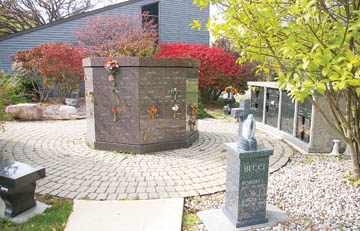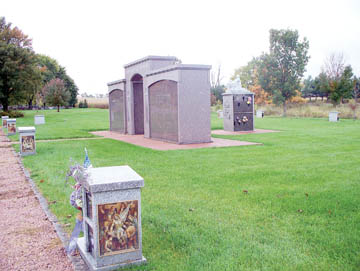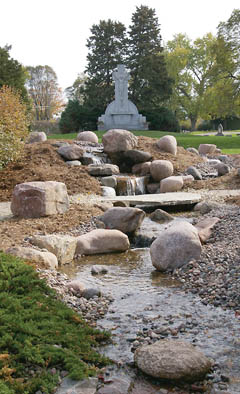


DIOCESE—“People want to be able to see different ideas for burial, inurnment or interment,” says Carol Giambalvo, CCCE, director of Catholic Cemeteries in the Diocese of Rockford.
The Catholic Church, she says, allows cremation, but states that the cremated remains (sometimes informally called “cremains”) must be buried or inurned.
“Obviously, the cremation rate is growing in Illinois,” Giambalvo adds, “and our cemeteries are trying to be prepared for that trend.”
In addition to offering the traditional burial of bodies or cremated remains in the ground or above ground in mausoleums, some cemeteries offer placement of inurned cremains in a designated niche designed for that purpose.
In Geneva, Resurrection Cemetery currently is adding onto its existing mausoleum. A new garden in back will feature a pergola-shaded columbarium — a place for respectful storage in cinerary urns (urns holding a deceased person’s cremated remains). This “Garden of the Little Flower” is scheduled to be completed before winter.
The new construction at Resurrection Cemetery will add 96 crypts for full bodies (single and double) and 128 individual and 32 double niches, some on the side wall of the mausoleum and some in the garden.
Mount Hope Cemetery in Elgin has a new 98-space columbarium of a different design, Giambalvo reports. Access to the niches is only available for cemetery personnel from the inside, with the name of the deceased and a vase for flowers on the outer wall.
“As far as I know, it is the only one in the country” built like this, Giambalvo says, adding that a granite company in Canada she works with comes up with different ideas. The point of this design, she adds, is to prevent attempts at vandalism.
Additionally, under construction at Mount Hope is a pond-less waterfall, much cleaner and easier to maintain than the original pond.
At Calvary Cemetery near Rockford is a new, columbarium with more than 300 niches toward the front of the cemetery in the Way of the Cross section. The new “Garden of Gethsemane” features an archway and a statue of Jesus in the Garden that was donated by the cemetery and priests of the diocese, Giambalvo says. Other carvings and Stations of the Cross are part of the new garden’s design.
For centuries the Catholic Church forbade Catholic burial to those who ordered that their bodies be burned after death. The practice was historically an act of disbelief in immortality by the members of certain societies and others.
Cremation now is allowed by the Church provided it “does not show any contempt of the Church or religion or deny, question or belittle the teaching concerning the resurrection of the body,” according to the 1976 Catholic Encyclopedia.
In short, the Church requires that reverence be shown to the human body, the temple of the Holy Spirit.














